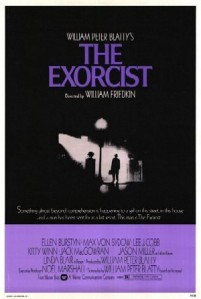December 26: Exorcism
The Exorcist Released (1973)
Religion and Exorcism
It was on this date, December 26, 1973, that "The Scariest Movie of All Time" — The Exorcist — premiered in the United States. Initially earning an MPAA rating of "X," it subsequently settled on an "R" for violence, horror effects, rampant blasphemy, and — oh yes — some sexual manipulation of a crucifix. The picture, directed by William Friedkin (who also directed The French Connection, 1971), was based on the novel and written for the screen by William Peter Blatty. Blatty was a Georgetown University student when the real events occurred on which his best-selling novel is based.
The Exorcist sets up a classic confrontation between religion and science, in a battle over the life, and presumably the soul, of a 12-year-old girl (played by Linda Blair) who is behaving strangely. When all scientific methods fail to discover the cause, she is assumed to be possessed of the devil. That is what a younger priest (played by Jason Miller) reluctantly concludes, but the older priest (played by Max Von Sydow) knows the devil when he sees it and the casting-out ceremony becomes the centerpiece of the film.
To no one's surprise, there was an upsurge in demand for exorcisms just after the release of the film. Theater patrons screamed and fainted at the film, while others sought paramedics. The Exorcist was effective not because of gross-out special effects, but because the actors and director made you care about the characters and made the audience feel there is some shared value at risk. Rumors persist that ominous events surrounded the filming, including deaths and a mysterious fire. Ellen Burstyn, who played the girl's mother, agreed to do the movie only if her character didn't have to say the scripted line: "I believe in the devil!"
The director asked technical advisor Thomas Bermingham, a cleric, to exorcise the set. Instead, Bermingham gave a blessing and a talk to reassure the cast and crew. This didn't help Christian evangelist Billy Graham, who claimed an actual demon was living in the celluloid reels of the movie!
Exorcism predates Christianity. It was a popular Jewish belief, noted by Josephus and practiced by Solomon, and found also in Egypt and Babylonia. The tradition is specifically endorsed by the Jesus of the Gospels. Indeed, the Gospels held the power of exorcism to be a sign of Messiahship. Jesus delegated this strange power to cast out demons to anyone who believed in him.
From the Middle Ages to the dawn of the 1800s, the mentally ill were presumed demon-possessed. Consequently, exorcisms were much more common. Typically, the most brutal and disgusting means were employed to drive out the devil. Even animals were treated as possessed by demons and solemnly tried in court, suffering the same punishment, usually burning or hanging, as their unfortunate human associates.
The Catholic Encyclopedia endorses exorcisms; the website catholiceducation.org recognizes the rite to this day, warning its readers to stay away from Ouija boards! In November 2010, in Baltimore, Maryland, more than 100 Roman Catholic priests and bishops gathered for a two-day closed conference on exorcism.
"Not everyone who thinks they need an exorcism actually does need one," Bishop Thomas Paprocki said. "It's only used in those cases where the devil is involved in an extraordinary sort of way in terms of actually being in possession of the person. But it's rare, it's extraordinary, so the use of exorcism is also rare and extraordinary. But we have to be prepared."
Many Protestant sects believe in demon possession, and there is an exorcist tradition in Islam: possessions of humans by djinni (جني jinnī), and their expulsion by Muslim exorcists, have been recorded in Egypt, Sudan, Saudi Arabia, Bahrain, Pakistan and India.
According to Robert Todd Carroll's Skeptic's Dictionary,
Most, if not all, cases of alleged demonic possession of humans probably involve either people with brain disorders ranging from epilepsy to schizophrenia and Tourette's syndrome... the behaviors of the possessed resemble very closely the behaviors of those with electrochemical, neurochemical or other physical or emotional disorders...*
We can read about secular exorcisms today from therapists treating patients with so-called Multiple Personality Disorder (MPD or dissociative identity disorder): psychiatrists ridding patients of their "entities," which are most likely artifacts of the psychiatrist’s suggestion. Is The Exorcist a triumph of superstition over science? Whether demons or "personalities," there is just as much evidence of the existence of either — which is to say: none.
* The full article on exorcism from Carroll's website can be found at this link. An interesting article from the same website, more or less explicitly linking MPD and demonic possession, can be found at this link. Carroll does not specifically endorse this writer's conclusion.
Originally published December 2003.


